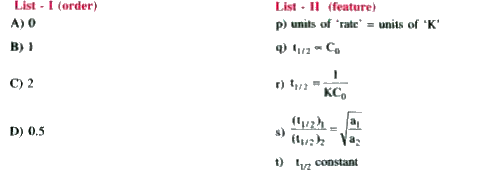H2O21storder−−−−→H2O+12O2. Pressure of O2 is recorded as:
time (min) 10 min ∝
PO2 (mm) 120 160
What is half life?Solution in Telugu
The correct Answer is:5
H2O2O2→H2O+12O2
C0P0=0
(C0−x) Pt=120
0 Pα=160
KX2.30310=log16040,t12=0.693k=5
H2O2→H2O+12O2
Topper's Solved these Questions
- BOOK - AAKASH SERIESCHAPTER - CHEMICAL KINETICSEXERCISE - PRACTICE SHEET-1 (SINGLE OR MORE THAN ONE OPTION QUESTIONS)16videos
CHEMICAL KINETICS
- BOOK - AAKASH SERIESCHAPTER - CHEMICAL KINETICSEXERCISE - PRACTICE SHEET-1 (LINKED COMPREHENSION TYPE QUESTIONS)6videos
CHEMICAL KINETICS
- BOOK - AAKASH SERIESCHAPTER - CHEMICAL KINETICSEXERCISE - LEVEL-II(LECTURE SHEET EXERCISE-III MATCH THE FOLLOWING QUESTIONS)3videos
CHEMICAL KINETICS
- BOOK - AAKASH SERIESCHAPTER - CHEMICAL KINETCSEXERCISE - EXERCISE - 3.245videos
CHEMICAL KINETCS
- BOOK - AAKASH SERIESCHAPTER - CHEMICAL THERMODYNAMICSEXERCISE - Additional Practice Exercise54videos
CHEMICAL THERMODYNAMICS
Similar Questions
For the reaction N2+3H2→2NH3 , the rate d[NH3]dt=2×10−4Ms−1. Therfore the rate −d[N2]dt is given
01:51View SolutionThe instantaneous rate of an elementary chamical reactkon aA+bB⇔cC+dD can be given by rate =Kf[A]a[B]b−Kb[C]c[D]d where Kf and Kb are rate constants for forward and backward reactions respectively for the reversible reaction. If the reaction is an irreversible one, the rate is expressed as, rate =K[A]a[B]b where K is rate contant for the given irreversible rate of disappearance of A is a/b times the rate of disappearance of B. The variation of rate constant K with temperature is expressed in terms of Arrhenius equation: K=Ae−Ea/RT whereas the ratio KfKb is expressed in terms of van't Hoff isochore: KfKb=Ae−ΔH/RT, where Ea and ΔH are energy of activation and heat of reaction respectively.
The variation of rate constant K and KfKb with temperature shows the following effects:
For endothrmic reaction when T increases then K increases and KfKb also increases.
(ii) For endothemic reaction when T decreases then K decreases and KfKb also decreases.
(iii) For exothermic when T increases then K and KfKb both increases.
(iv) For exothermic reaction when T decreases then K increases and KfKb decrease.
(v) For exothermic reaction when T increases thenK and KfKb both decrease.03:28View SolutionMatch the following columns
 View Solution
View SolutionDiscuss on the kinetic spontaneity of a chemical reaction. Is a slow reaction spontaneous? Why?
01:52View SolutionWhich among the following is not an exact differential?
03:53View SolutionDecomposition of H_(2)O_(2) , is a first order reaction. A 16 volume solution of H_(2)O_(2) of half life 30 min is present at start. When will the solution become one volume?
02:00View Solution(a) H2O2+O3→H2O+2O2
(b) H2O2+Ag2O→2Ag+H2O+O2
Role of hydrogen peroxide in the above reactions is respectively06:20View SolutionI. H2O2+O2→H2O+2O2
II.H2O2+Ag2O→2Ag+H2O+O2
Role of hydrogen peroxide in the above reactions is respectively02:30View Solutionनिम्नलिखित अभिक्रिया में ऑक्सीकारक छाँटिए-
H2O2+O3→H2O+2O201:59View SolutionH2O2R.T.−−→H2O+12O2
03:53View SolutionP4O102H2O−−→H4P4O12H2O−−→H6P4O132H2O−−−−−→−2H3PO4H4P2O7H2O−−→2H3PO4
From the above process, find the total number of P−O−P linkage in H6P4O13.View Solution(a) H2O2+O3→H2O+2O2 (b) H2O2+Ag2O→2Ag+H2O+O2
उपर्युक्त अभिक्रियाओं में हाइड्रोजन परॉक्साइड का कार्य है -08:00View SolutionH_(2)O_(2) + O_(3) rarr H_(2) O_(2) + 2O_(2) (II) H_(2)O_(2) + Ag_(2)O rarr 2Ag + H_(2)O + O_(2) Role of hydrogen peroxide in the above reactions is respectively-
02:23View SolutionIn the following reaction 2H_(2)O_(2) rarr 2H_(2)O + O_(2) rate of formation of O_(2) is 3.6" M min"^(–1) . (A) What is rate of formation of H_(2)O ? (B) What is rate of disappearance of H_(2)O_(2) ?
02:21View SolutionH2O2R.T.−−→H2O+12O2
01:54View Solution

